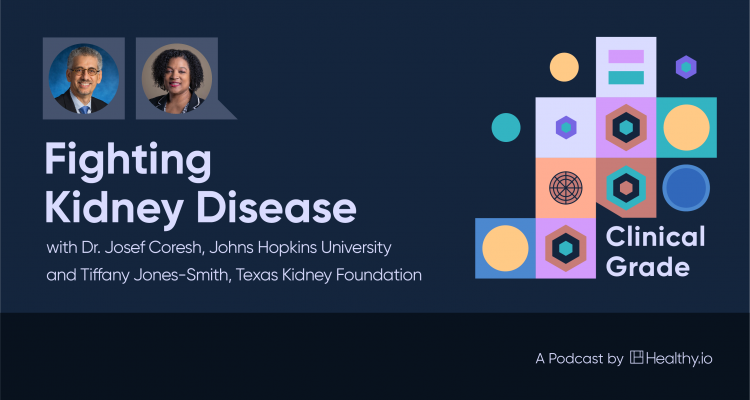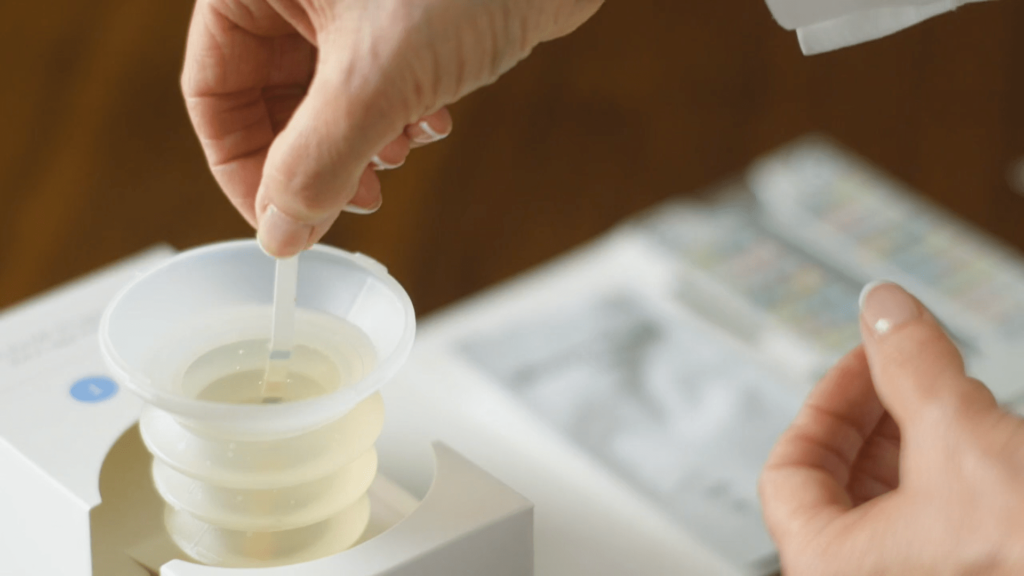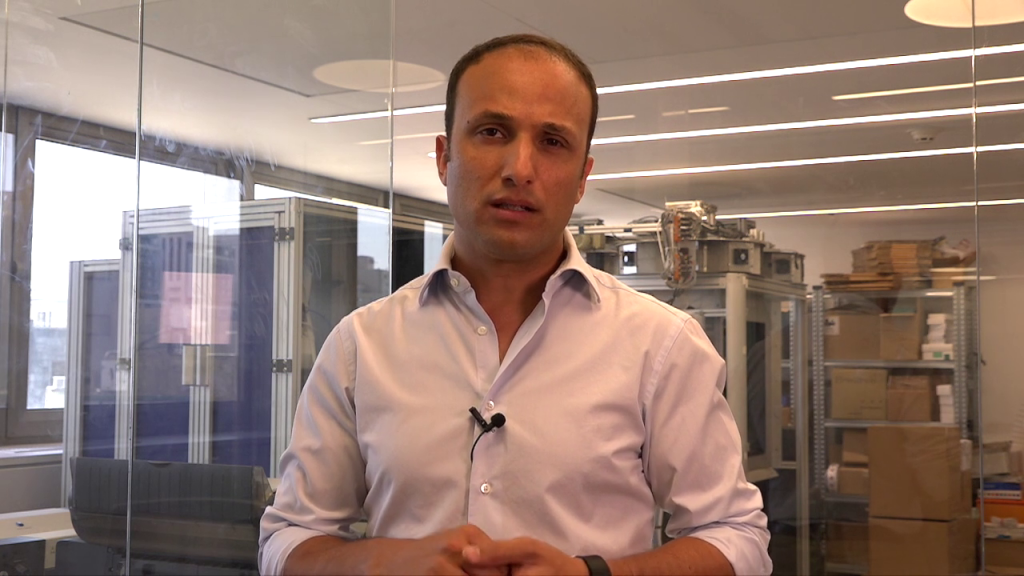Listen now:
In our latest episode of Clinical Grade, you’ll meet two remarkable individuals playing important roles in the fight against chronic kidney disease (CKD). First, we speak with Dr. Josef Coresh, Professor of Epidemiology, Biostatistics & Medicine at Johns Hopkins University. Not only is Dr. Coresh one of the world’s leading kidney disease experts—he helped classify the disease, and shaped the clinical guidelines for treating it. We discuss the high prevalence and low public profile of chronic kidney disease, the mechanics of early detection, and some reasons for optimism.
Then we check in with Tiffany Jones-Smith, CEO of the Texas Kidney Foundation and a member of the Texas Chronic Kidney Disease Task Force. She’ll tell us about the special challenges facing the Lone Star State and our new partnership that’s bringing at-home early-detection kits to Texans.*
You can listen to Clinical Grade using the player above, and subscribe on Apple Podcasts, Spotify, Google Podcasts, or wherever you get your podcasts.
Episode Transcript
Part 1: Dr. Josef Coresh, Johns Hopkins University
Dr. Coresh, in your paper on the prevalence of chronic kidney disease in the United States you found that the prevalence had increased dramatically at a certain point. Is that still the case today?
Dr. Josef Coresh It was important to get a standard definition of chronic kidney disease in the United States and globally. I was fortunate to be a member of a work group led by Andrew Levie and sponsored by the National Kidney Foundation to think of a standard definition. When you apply the standard definition, you find that the prevalence of chronic kidney disease is very high: about 10 percent in the US population and globally. The prevalence increased for a while. Fortunately, it’s stabilized somewhat, as have the rates of dialysis. But as the population gets older, even with the same rates, we’re experiencing a greater burden of disease.
One of your more disturbing findings is that despite the high prevalence of CKD, many people who have it don’t know they have it, even in rather advanced stages where kidney function is impaired. Why is the public profile of CKD so low?
Dr. Coresh I think people are aware of kidney dialysis and transplantation, but that is sort of the tip of an iceberg. So in the US, there are about 600,000-700,000 people who have kidney failure requiring kidney dialysis or transplantation. Once we define kidney disease in a standard way, we realize that it really starts much earlier. And the total iceberg is just much larger. So if we’re talking about 10 percent of the adult population, we’re talking about 20 million people. The process of educating the public, talking to physicians, and getting the language out there is just a few decades behind. And it’s also a disease where the symptoms are not very specific until very late. So it’s harder. You don’t hurt in your kidneys, the kidneys just function less, and then the body suffers the consequences. So altogether, we really have a long way to go with kidney disease awareness.
We sometimes hear that detecting CKD in its early stages is not a high priority, because progression can take a while. I suspect you disagree.
Dr. Coresh Well, I think there are huge benefits for early detection. You can make progress and do some good at every stage. But the earlier stages where kidney function—glomerular filtration rate, the amount the kidney filters—is intact, especially if you have damage due to albuminuria detected with protein in the urine. That is a reversible part of the disease. We know we can lower albuminuria and actually get the kidney to assume a much healthier pose later on in the disease. You lose glomeruli—the filtering units in the kidney, and that loss is irreversible. So at that point, you can just kind of slow down further loss and further damage. So clearly, earlier detection is important and detecting both albuminuria and the level of GFR is important. And that’s why currently the staging is by both criteria: albuminuria and GFR.
How exactly does ACR testing contribute to early detection?
Dr. Coresh In staging kidney disease we focus on the kidney function, the glomerular filtration rate, which counts the number of functioning units, and that irreversibly gets lost. The other key measure of damage is the protein in the urine, which measures the ability of the kidney to keep the important proteins in the body rather than having a leak into the urine. The dominant protein is albumin. It’s standardized for creatinine, which is why it’s a ratio—we want to make sure that if you drink a lot of water and the urine is diluted, it doesn’t hide the fact that protein is spilling into the urine. We detect this protein to creatinine ratio measured by albuminuria or ACR. An elevated level of albuminuria is a marker of kidney damage and a very strong risk factor for a whole host of complications, including the risk of long term dialysis, the risk of cardiovascular disease, heart disease, heart failure, stroke hospitalizations, as well as other complications.
We see in the data that oftentimes people at risk for CKD will have their eGFR tested, but not their ACR. Why is it important that we test both? And how are the two tests complementary?
Dr. Coresh With estimated GFR, which we get from a blood test of serum creatinine, I think we did a good thing in 2002 where we recommended guidelines and helped labs implement a formula that calculates it automatically. As soon as a doctor orders this lab test, they get the result. And fortunately, this lab test is bundled with some routine lab tests that are done. So we have nearly all patients that are under routine care getting tests for estimated kidney function. We still need to get awareness and action with albuminuria. You clearly need another test because it’s urine. We need to make sure that awareness is high enough, that testing is done and the follow up is done. And I think that is the challenge for the coming decade.
We know that despite everything you just explained, ACR testing for at-risk populations remains quite low. Why is that?
Dr. Coresh Yes, indeed, unfortunately, albuminuria testing is not at the recommended level for people with diabetes. The recommendations have been clear to do annual testing, and we find that in very well organized systems you can achieve rates greater than 90 percent. Unfortunately, the average rates in the US hover around 50 percent or so, and are widely variable across locations. I think it’s somewhat understandable in that patients are used to coming to a clinic. They may need to give blood, in which case you give a whole range of tests. For urine you need a different kind of specimen and you need a different kind of facility. And so it takes a little more time. It takes a little bit more awareness to make sure that tests are ordered. And we know that awareness of kidney disease and awareness of albumin as a risk factor are lower. I think it’s somewhat unfortunate because we actually have agents that can really target albuminuria and lower albuminuria risk: ACE inhibitors and ARBs. Recently we have other classes of drugs like the SGLT2 inhibitors, which impressively take people at very high risk and lower their risk. So I think it’s a good time in that we have more tools and we need to do better than we’ve been doing.
You took part in a clinical trial that examined how Healthy.io’s at-home kidney screening service can help improve adherence to ACR testing. What were some of the key discoveries, and how does our method fit in with your broader vision for the fight against kidney disease?
Dr. Coresh It was my pleasure to collaborate with Dr Alex Chen at the Geisinger Health System, working with the National Kidney Foundation, and funded by Healthy.io providing kits. We tested the idea that if you send patients a box with instructions to test their urine at home—more patients would do that than if you send them a letter and say, come to the clinic and do the urine test there. And indeed, we found a difference, which makes sense. And it was good to confirm that patients were able to—in rural Pennsylvania without too much selection—follow the instructions, use the smartphone camera, and very much the way you deposit a check these days, deposit their urine test result.
Let’s try and end on an optimistic note. What are some of the more promising avenues of treatment for CKD? And how can early detection and intervention contribute to the effectiveness of such treatment?
Dr. Coresh I think we live in challenging times. On the other hand, I think there’s a lot of reasons for optimism. I think we’ve seen that new drug development is much more energized than it was 20 years ago due to the successes of some of the recent agents. The SGLT2 inhibitors in particular—but there are other drugs for diabetes as well that reduce risk, act on the kidney, and reduce heart disease risk dramatically. So we’re getting more and more clinical trials every year to see that. And finally, I’m quite encouraged by technology and combining technology with medicine in that I think people are now used to doing things with their phones. Tools like Healthy.io’s bring the technology of cameras that are very sophisticated and can do a lot more than just take a selfie. They actually deposit your medical information from home right into your medical record, connect that to your doctor, connect that to action. My hope is that we’ll get better health, better care—and it might be a better future.
Part 2: Tiffany Jones Smith, Texas Kidney Foundation
Thanks for joining us. I’ve heard that you like to describe yourself as a kidney crusader. How did you become a kidney crusader, and what does that mean?
Tiffany Jones-Smith I describe myself as a kidney crusader because crusaders have a cause and a reason why they’re doing what they’re doing. It’s more than just a battle or a war. A crusader is in it for the long haul. And that comes from losing nine family members to chronic kidney disease. When I took this job, I was really trying to figure out what happened to my family? I had a little cousin, and I remember the day his mom brought him home from the hospital. He went into renal failure at 21 on the side of the road. We’ve been dealing with that ever since. That’s how I ended up getting involved with the Texas Kidney Foundation, trying to figure out the problem. Why don’t people know about kidney disease? Why is it so prevalent? One in three are at risk for kidney disease, one in seven have some form of kidney disease and are unaware of it. Those are the normal numbers right now in the United States. So think about that. That’s not a good premise there. We are facing down something that could be catastrophic. In terms of human value, which to me is the most important commodity that the United States has—human beings—you’re talking about a devastating experience, to have a chronic illness. And then monetarily, you eventually hit a wall with health care costs.
What are those costs like in Texas?
Jones-Smith Right now, Texas spends 4.8 billion dollars a year on end stage renal disease. That’s 10 percent of the end stage renal disease population of the United States. You’re talking about huge numbers. And the estimates are for our CKD population—the other stages of kidney disease that lead to end stage renal disease—15 billion dollars a year. Not 15 billion dollars of the total lifespan of the chronic illness: 15 billion dollars every year.
That reality you’re describing is the reason why we’re very excited about our new partnership, supporting the TKF’s Silent but Deadly campaign. How has the response been so far?
Jones-Smith We didn’t know what people were going to think or do, because people tend to be complacent about health. And when we launched on World Kidney Day, we really saw a great response, a great response with the English-speaking community and with the Hispanic community. That was an exciting thing because we were expecting to have to work a lot harder to get people to pay attention to their health. But they are. We’ve all been under lockdown for a year, and people are ready to be out and about. But they are thinking about living and the quality of their lives, which is what we’re really emphasizing here. You know, this isn’t just the product. This is your lifeline to a healthy life. It’s the first step in you receiving what you need, which is agency and health. If you make the decision to go and order a test kit, you don’t have to do anything—you’re a few clicks away from getting this sent to you.
Let’s take a step back and talk about Texas. What are some of the unique challenges Texas faces with regards to kidney health, and what are you doing to address those?
Jones-Smith There are unique challenges in the sense that you hear these wonderful statements about cost of living: “Cost of living is low in Texas.” Well, what cost of living being low means is that people aren’t being paid very much in Texas. And so we have food deserts, and we have a number of social determinants of health that play a role in the quality of life, and people having chronic illnesses like diabetes and hypertension. So if you’re in the middle of a state, where Dallas and Houston are, then hypertension is more prevalent. And then as we go further down the state of Texas, along the border—that is one of the hardest-hit areas for chronic kidney disease. That’s why the Texas Kidney Foundation is located here, because we really serve that South Texas region and put a lot of emphasis on it. They are among the poorest and unaware of kidney disease. We spend a lot of time myth-busting and just assisting in all of the one-offs, those social determinants of health that are so prevalent in this disease.
You were appointed by the governor to serve on the Texas Chronic Kidney Disease Task Force. What do you tell state officials to convince them that we all need to start paying attention to kidney health on a population–wide level?
Jones-Smith Well, I tell state officials that the most important thing we have in our state is the people. You don’t have an economy if the people are sick. There is no state of Texas if there are no Texans. If everyone is suffering from an assortment of chronic illnesses, how are we going to function economically? The argument being made nationally and statewide is economics. We’ve got to get back to work. We’ve got to open things up. You can’t get back to work and open things up if the people are sick. You know, Texas is a red state. We talk all the time about fiscal responsibility. Well, you tell me, is it more fiscally responsible to raise numbers exponentially, raise health care costs exponentially, when you have the answer and that’s Healthy.io. You have the answer to stopping those numbers, to stopping them cold: identify it and begin to treat. That’s it. That’s a simple Texas answer, Texas ingenuity right there. Boom. I just told you what we need to do. Let’s go do it. You know? And that’s essentially what I say to them: you have no Texas without Texans. We have every tool we need to identify this disease. And we have every tool we need to help people move away from it, slow it down, and stop it in its tracks.
* The home-testing device is currently limited to investigational use in the United States.











